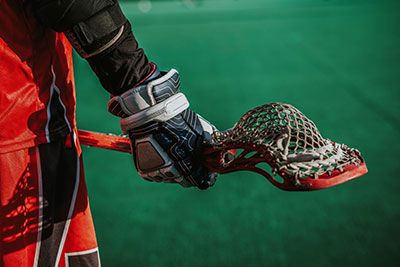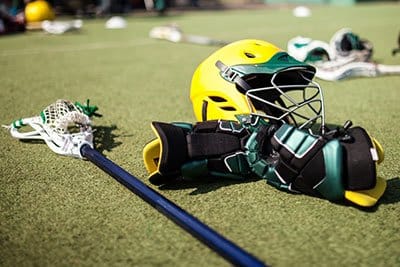Lacrosse has seen an increase in the use of illegal equipment by players, coaches, and referees alike. The sport has evolved over the years, and the rules governing equipment use have become more complex, leaving many players and teams in a difficult position when determining what is and isn't allowed.
Because of this, understanding why some pieces of lacrosse equipment are deemed illegal is essential for any player or coach looking to stay in compliance with the rules.
This article will provide an overview of the current state of boys' lacrosse rules regarding illegal equipment so that you can make an informed decision for yourself on whether or not to get involved.
More...
Take away key points:
What is illegal equipment use in lacrosse?
Illegal equipment use in lacrosse is defined as using secondhand, modified, or unapproved gear in sanctioned games. This includes gear that may have been altered from its original design, such as sticks that are longer than their specified length or have had extra material added to increase their weight.
Boys' lacrosse consists of ten players on the field at once: a goalkeeper, three defensemen, three midfielders, and three attackmen. This contact sport is full of energy and excitement! However, it's necessary to do frequent cross-checking of the defending team and the offensive end as well as to have the required equipment as demanded by a head coach.
Illegal equipment use in lacrosse is the practice of using pieces of gear that have not been approved by governing bodies such as the National Federation of State High School Associations (NFHS) or the NCAA.
It also includes any gear or accessories not authorized by the governing body of a particular league or tournament, such as jewelry and custom-built helmets. It's important to note that these rules apply both on and off the field; if a player is found with illegal equipment during practice or at home, they can still face disciplinary action.
Illegal equipment use can lead to serious consequences, such as ejection from matches and forfeiture of games, so it's important to understand which pieces are allowed and which are not.

Lacrosse rules for using equipment
Different lacrosse leagues have their own individual rules regarding the use of equipment. As such, it is essential to be familiar with your particular league's regulations and ensure that any gear you use is approved.
The NFHS and NCAA both maintain lists of illegal pieces of equipment, so be sure to check those before going out to play. Additionally, some leagues require players to wear protective eyewear to participate, so make sure you follow your local laws for safe sporting activity.
Even if an item isn't explicitly listed as being illegal by the governing body, it's important to remember that any piece of equipment that gives a player an unfair advantage is generally prohibited.
This includes items such as modified sticks or longer shafts that could allow for extra reach or power and anti-gravity shoes, which boost elevation when jumping. Take care when adding anything new to your playing kit before heading out onto the field, and stay mindful of the rules to avoid any potential issues.
Examples of illegal lacrosse equipment use
Some examples of illegal lacrosse equipment violations include using a stick with an oversized head, a pocket that exceeds the maximum depth allowed, or a stick with a shaft that is too long for a specific player.
Illegal equipment violations include any type of altered or modified stick, end cap, arm pads, illegal gloves, and sticks longer than the standard 6' length or a deep pocket than regular. In addition, the overall length of the stick must be in accordance with the regulations.
Non-wood/composite shafts, heads that have been drilled for stringing purposes, and pits made with soft or flexible material are also banned from team use. In addition, non-approved headgear and protective gear are not allowed during play.
Additionally, some sticks may be made from materials such as aluminum or titanium, which are both prohibited. Other infractions include wearing body-protecting gear not approved by the governing body and possessing any type of performance enhancers such as drugs or supplements.
Players should always strive to use only legal items during play to avoid any issues.
Additionally, players who use a lacrosse stick to endorse an illegal procedure such as unnecessary roughness, body contact, and similar may receive personal foul and penalty time.
Remember that only a coach can announce an equipment check.
What makes a lacrosse stick illegal for use?
A lacrosse stick is deemed illegal if it does not meet the National Federation of State High School Associations (NFHS) standards. These standards set forth the specifications for a legal lacrosse stick, including maximum length, minimum depth of pockets, and restrictions on material composition. Other stick violations include string tightness, legal shooting strings, or measurements of the head.
Sticks must also be officially certified or marked with an NFHS approval label to indicate that the item meets these standards. If a stick does not have this approval label, then it cannot be used in competitive games and is considered illegal equipment.
Players should pay attention to these rules when shopping to ensure they only purchase sticks approved by their league.
The consequence of using illegal lacrosse equipment
Illegal equipment use in lacrosse can come with serious consequences. Depending on the severity of the offense, players may face ejection from a game or even forfeit their team's entire match.
In some cases, if an item is considered particularly dangerous or illegal, it could lead to further disciplinary action from governing bodies and even bans on participation within a certain league or competition. In extreme cases, a player could also face criminal charges for using prohibited materials in an official match.
It's important to remember that penalties for illegal equipment use are no laughing matter and can have serious implications for your ability to play in the future. Therefore, it's always better to err on the side of caution and make sure that you only use pieces that have been approved by governing bodies like NFHS and NCAA.
Players can also be sent to the penalty box, where they must remain until the penalty time expires.
At higher levels of play, consequences can include disqualification from tournaments and permanent bans from leagues or organizations. It's important to remember that any use of banned items will likely result in criminal prosecution, so take extra precautions when choosing your playing gear to avoid any potential issues with the law.
How does the referee react to illegal equipment use?
Regarding illegal equipment in lacrosse, referees tend to take a zero-tolerance approach and will immediately eject any players they deem to be using banned items. In addition, referees are well-trained professionals who know the sport's rules inside and out, so they can quickly identify any violations of gear regulations.
If an illegal piece of equipment is used during a lacrosse game, the referee will typically stop playing and inspect the offending item. If found to violate the rules, the player who has gained possession of it will be ejected from the game and may face other consequences depending on the league's regulations.
The referee may also issue warnings to the team captain and other players if they are deemed to have knowingly used an illegal piece of gear. Additionally, any items determined to be dangerous or unsafe will be confiscated by the official and disposed of appropriately.
Penalties similar to use of illegal lacrosse equipment

Penalties similar to illegal lacrosse equipment in lacrosse include: stalling, unsportsmanlike conduct, offsides.
Stalling
Stalling is a penalty in lacrosse that occurs when an offending player holds the ball without attempting to score or pass it to an opposing player. The penalty stays in effect until the defensive team gains possession of the ball.
When a stalling penalty is called, the possession of the loose ball goes back to the defensive team.
Unsportsmanlike conduct
This unsportsmanlike conducts of penalty in lacrosse is when a player behaves badly or unfairly. This could include arguing with the referee, not following rules, and being mean to other players.
Depending on the severity of the situation, this conduct can result in a technical foul, personal foul, or penalty time.
Offsides
When too many players cross the midfield line, such as a defender half carrying the scooped ground ball over and a teammate not remaining on defense, an offsides penalty is incurred.
Final words
It is important to be aware of the laws and regulations regarding lacrosse use of illegal equipment. Players must always use approved, legal items while playing to avoid any penalties or suspension.
By following the rules and understanding what makes a stick illegal, players can ensure that their equipment is safe and compliant with the governing bodies of lacrosse.
